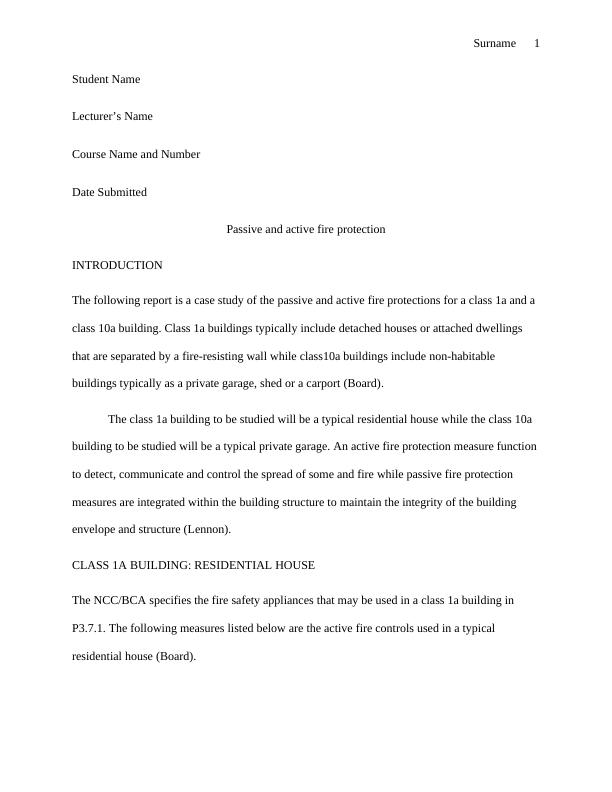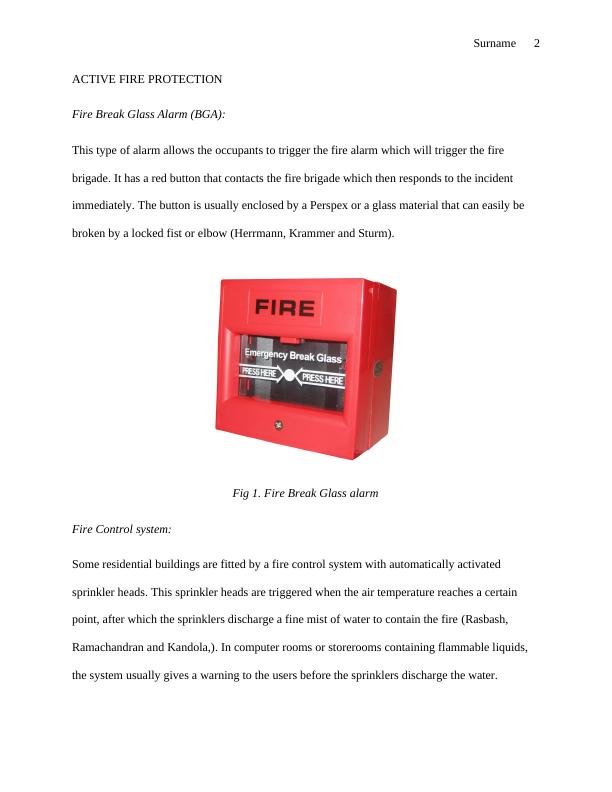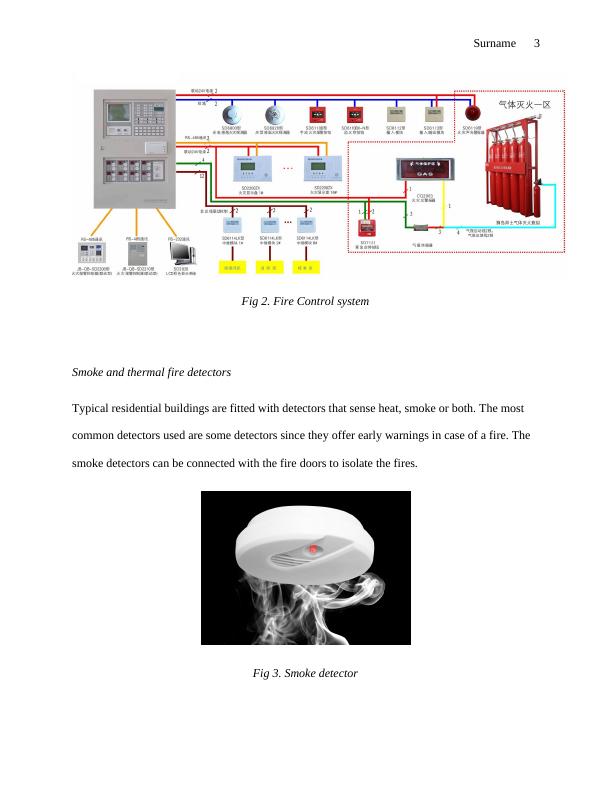Passive and active fire protection in class 1a and class 10a buildings
Added on 2023-06-10
11 Pages1243 Words349 Views
Surname 1
Student Name
Lecturer’s Name
Course Name and Number
Date Submitted
Passive and active fire protection
INTRODUCTION
The following report is a case study of the passive and active fire protections for a class 1a and a
class 10a building. Class 1a buildings typically include detached houses or attached dwellings
that are separated by a fire-resisting wall while class10a buildings include non-habitable
buildings typically as a private garage, shed or a carport (Board).
The class 1a building to be studied will be a typical residential house while the class 10a
building to be studied will be a typical private garage. An active fire protection measure function
to detect, communicate and control the spread of some and fire while passive fire protection
measures are integrated within the building structure to maintain the integrity of the building
envelope and structure (Lennon).
CLASS 1A BUILDING: RESIDENTIAL HOUSE
The NCC/BCA specifies the fire safety appliances that may be used in a class 1a building in
P3.7.1. The following measures listed below are the active fire controls used in a typical
residential house (Board).
Student Name
Lecturer’s Name
Course Name and Number
Date Submitted
Passive and active fire protection
INTRODUCTION
The following report is a case study of the passive and active fire protections for a class 1a and a
class 10a building. Class 1a buildings typically include detached houses or attached dwellings
that are separated by a fire-resisting wall while class10a buildings include non-habitable
buildings typically as a private garage, shed or a carport (Board).
The class 1a building to be studied will be a typical residential house while the class 10a
building to be studied will be a typical private garage. An active fire protection measure function
to detect, communicate and control the spread of some and fire while passive fire protection
measures are integrated within the building structure to maintain the integrity of the building
envelope and structure (Lennon).
CLASS 1A BUILDING: RESIDENTIAL HOUSE
The NCC/BCA specifies the fire safety appliances that may be used in a class 1a building in
P3.7.1. The following measures listed below are the active fire controls used in a typical
residential house (Board).

Surname 2
ACTIVE FIRE PROTECTION
Fire Break Glass Alarm (BGA):
This type of alarm allows the occupants to trigger the fire alarm which will trigger the fire
brigade. It has a red button that contacts the fire brigade which then responds to the incident
immediately. The button is usually enclosed by a Perspex or a glass material that can easily be
broken by a locked fist or elbow (Herrmann, Krammer and Sturm).
Fig 1. Fire Break Glass alarm
Fire Control system:
Some residential buildings are fitted by a fire control system with automatically activated
sprinkler heads. This sprinkler heads are triggered when the air temperature reaches a certain
point, after which the sprinklers discharge a fine mist of water to contain the fire (Rasbash,
Ramachandran and Kandola,). In computer rooms or storerooms containing flammable liquids,
the system usually gives a warning to the users before the sprinklers discharge the water.
ACTIVE FIRE PROTECTION
Fire Break Glass Alarm (BGA):
This type of alarm allows the occupants to trigger the fire alarm which will trigger the fire
brigade. It has a red button that contacts the fire brigade which then responds to the incident
immediately. The button is usually enclosed by a Perspex or a glass material that can easily be
broken by a locked fist or elbow (Herrmann, Krammer and Sturm).
Fig 1. Fire Break Glass alarm
Fire Control system:
Some residential buildings are fitted by a fire control system with automatically activated
sprinkler heads. This sprinkler heads are triggered when the air temperature reaches a certain
point, after which the sprinklers discharge a fine mist of water to contain the fire (Rasbash,
Ramachandran and Kandola,). In computer rooms or storerooms containing flammable liquids,
the system usually gives a warning to the users before the sprinklers discharge the water.

Surname 3
Fig 2. Fire Control system
Smoke and thermal fire detectors
Typical residential buildings are fitted with detectors that sense heat, smoke or both. The most
common detectors used are some detectors since they offer early warnings in case of a fire. The
smoke detectors can be connected with the fire doors to isolate the fires.
Fig 3. Smoke detector
Fig 2. Fire Control system
Smoke and thermal fire detectors
Typical residential buildings are fitted with detectors that sense heat, smoke or both. The most
common detectors used are some detectors since they offer early warnings in case of a fire. The
smoke detectors can be connected with the fire doors to isolate the fires.
Fig 3. Smoke detector

Surname 4
Portable fire extinguishers
Portable fire extinguishers are used to contain small fires. A typical residential household will
have fire extinguishers in the kitchen and the storeroom since they are more susceptible to fires.
The most common fire extinguisher used in a residential home contains wet chemicals or fire
blankets (Herrmann, Krammer and Sturm).
Fig 4. Fire extinguisher
PASSIVE FIRE CONTROLS
Board systems
The materials used for board systems are usually either gypsum plaster or calcium silicate.
Calcium silicate boards are made up of inert materials that are designed intact during the entire
fire incident. On the other hand, gypsum boards have good insulation properties; its resistance to
fire is aided by the presence of moisture within its particles which evaporates at high
temperatures (Lennon). The use of these board systems offers the users of the residential house
Portable fire extinguishers
Portable fire extinguishers are used to contain small fires. A typical residential household will
have fire extinguishers in the kitchen and the storeroom since they are more susceptible to fires.
The most common fire extinguisher used in a residential home contains wet chemicals or fire
blankets (Herrmann, Krammer and Sturm).
Fig 4. Fire extinguisher
PASSIVE FIRE CONTROLS
Board systems
The materials used for board systems are usually either gypsum plaster or calcium silicate.
Calcium silicate boards are made up of inert materials that are designed intact during the entire
fire incident. On the other hand, gypsum boards have good insulation properties; its resistance to
fire is aided by the presence of moisture within its particles which evaporates at high
temperatures (Lennon). The use of these board systems offers the users of the residential house

End of preview
Want to access all the pages? Upload your documents or become a member.
